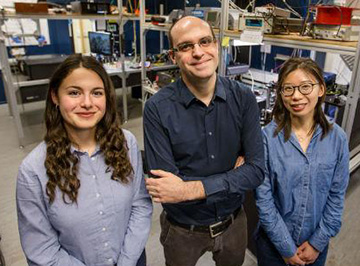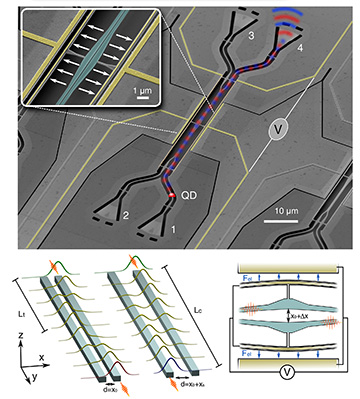![]()
A team led by scientists at the University of Copenhagen, Denmark, along with researchers at Ruhr-Universität Bochum, Germany, have devised a nanoscale router for single photons that combines nanomechanics and quantum photonics. [Image: Ola Jakup]
Researchers in Denmark and Germany have demonstrated a 5×30-micron coupled-waveguide device that can serve as a nanomechanical router for single photons pumped out of a quantum dot (Optica, doi: 10.1364/OPTICA.6.000524).
The tiny router, which can rapidly and efficiently shunt optical energy into one of two possible channels based on an externally applied voltage, could, according to the research team, provide a useful building block for compact, on-chip quantum photonic architectures. Such architectures, it’s thought, could help move forward development of deterministic photonic quantum logic gates, and ultimately of quantum information systems involving multiple quantum bits (qubits).
A tall order for integration
The ability to reconfigure photonic circuits on the fly and to route single photons to different destinations is essential to any realistic plans for a quantum computer—and it’s not a snap to accomplish at the chip scale. For one thing, the router technology must be fast enough to be compatible with the qubit’s coherence time—the interval during which the delicate quantum information embedded in the qubit remains intact. For single-photon emitters such as quantum dots, that time can measure on the order of microseconds.
Other challenges include keeping optical losses low and making the system scalable to the large numbers of circuits necessary for practical, multi-qubit quantum computing. Those challenges have proved difficult to meet with some common mechanisms used for tuning light propagation in optical devices. Tuning methods that rely on thermal effects, for example, tend to operate slowly and introduce noise, while those that rely on electro-optic effects can impose large device footprints that hold back scalabilty.
Taking advantage of coupled modes

Team leader Leonardo Midolo (center), with first authors Camille Papon (left) and Xiaoyan Zhou (right). [Image: Ola Jakub]
In the quest to get past those roadblocks, the Danish–German team, led by Leonardo Midolo of the University of Copenhagen, focused on a particular candidate for a quantum circuit element: a nanophotonic waveguide, with an embedded indium arsenide (InAs) quantum dot serving as a single-photon emitter. To build a router for shifting quantum-dot-emitted single photons between such waveguides, the researchers cleverly built on a fascinating detail of waveguide propagation.
When two parallel waveguides lie close enough together, the optical modes within them can become coupled, as a result of evanescent waves leaking from one waveguide to the other. As a result, the waveguides can exchange optical power in a periodic fashion over a given propagation distance, with the power essentially flopping between one waveguide and the other as the light propagates.
It turns out that the “transfer length”—the propagation distance across which the optical power in one waveguide in a coupled-waveguide system is fully transferred to the other waveguide—is mathematically related to the gap between the two parallel waveguides. This, the research team reasoned, offered the foundations for a two-output single-photon router, in which the propagating photon’s output port is selected by dynamically changing the distance between two nanophotonic waveguides.
Gap-variable coupler
The nanomechanical router works by applying a voltage to change the gap between two closely spaced, coupled-mode waveguides. This, in turn, changes the distance over which the optical energy from one coupled waveguide will transfer to the other, allowing routing of single photons between two output ports using an applied voltage. [Image: Papon, Zhou et al., Optica, doi: 10.1364/OPTICA.6.000524] [Enlarge image]
To build the nanophotonic router, the team began with a 160-nm-thick layer of gallium arsenide (GaAs), including embedded InAs quantum dots, and used electron-beam lithography to carve parallel waveguides approximately 200 nm apart, with one of the waveguides containing a quantum dot. The waveguides are tied to branching input and output fiber connections at either end. Along a roughly 18-μm stretch, the parallel waveguides are connected with thin tethers to parallel electrodes, which form capacitors on either side.
When a voltage is applied, the electrodes increase the gap between the waveguides by a tiny amount (up to around 70 nm). That gap change, in turn, reduces the transfer length of the coupled-waveguide system to just the right amount for the optical power to exchange from one waveguide to the other, thereby allowing the single photon to be routed to the other waveguide using the voltage signal.
Toward multi-qubit systems
In tests of the device at cryogenic temperatures, the researchers found that their gap-variable coupler proved highly effective at shunting single photons between the waveguides. The device logged a maximum extinction ratio—the ratio between the optical power in the two waveguides—of 23 dB, an indication of a splitting ratio of some 99.5 percent for the router. Meanwhile, insertion losses were a small 0.97 dB. And the nanomechanical router’s response time came in below 1 microsecond, approaching the coherence time of spin information in quantum-dot-generated single photons.
While the initial tests run by the Copenhagen-led team involved single qubits, the researchers believe that the device’s efficiency and small size offer particular promise for building multi-qubit quantum information systems that can be shrunk to chip scale. The team has calculated that a cascade of the prototype nanomechanical routers could be used to create a 10-photon (and, hence, 10-qubit) source. And, Midolo notes, further improvements in the device could boost that number to greater than 50 qubits—an important benchmark for “quantum supremacy” over classical algorithms for solving certain problems.
Small as the prototype router’s 150-μm2 footprint is, Midolo and his colleagues believe that the device can get even smaller and faster. The authors “estimate that a single-qubit unitary gate composed of a controllable beam splitter and a phase shifter could be built with a footprint smaller than 30 μm2 and with a response time of 100–200 ns” using their architecture. “With such an approach,” they conclude, “fully integrated photonic quantum processing may be within reach.”

